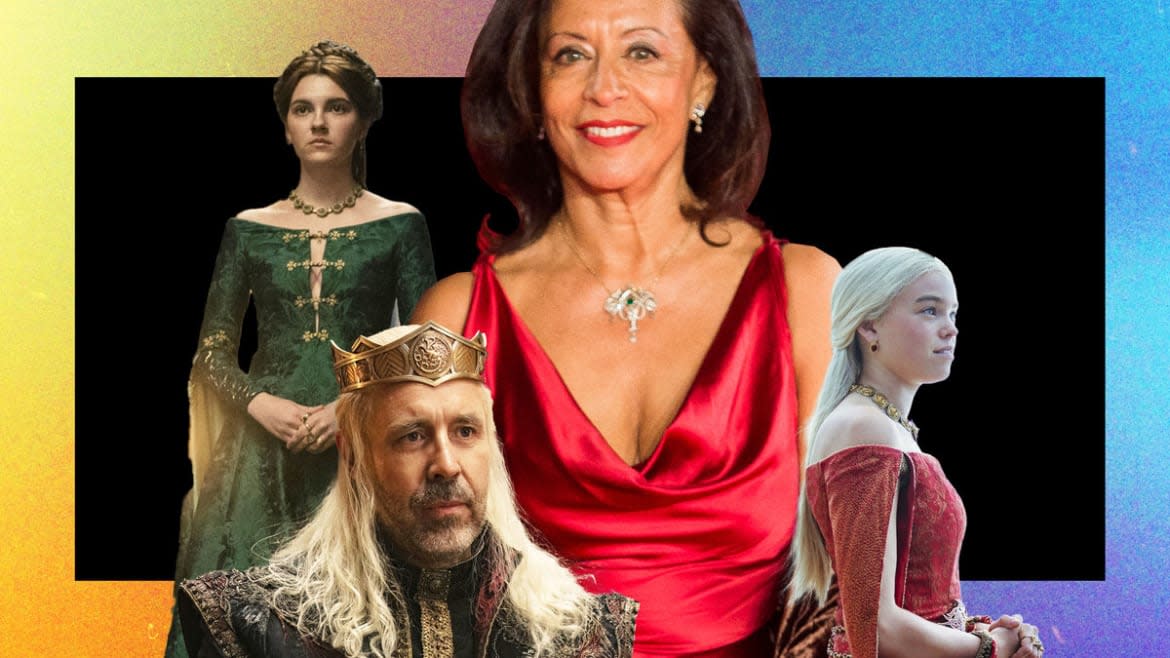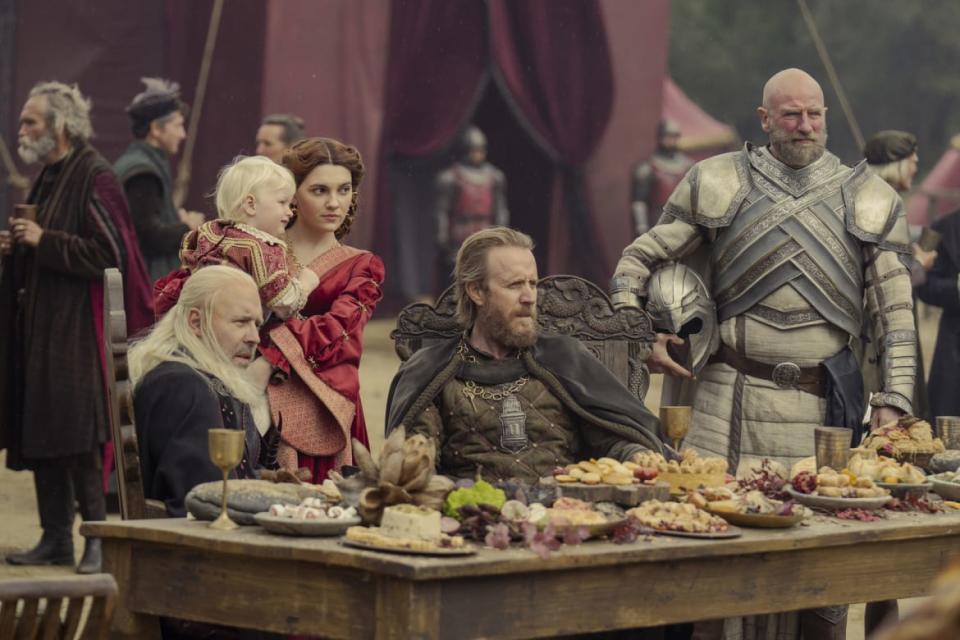‘House of the Dragon’ Does Its Best Storytelling Through Its Fashion

Yes, HBO’s House of the Dragon—set almost 200 years prior to the first episode of Game of Thrones—has the titular flapping fire-breathers, plus bloodshed, intrigue, scheming, sex, more scheming, and more dragons. But the series also boasts some of the most creative and detailed costume design work seen on television in recent memory. The wardrobe of the series helps further define each character’s power, and can track how their personalities and journeys change over time. The costumes are, of course, visually stunning, but they also tell a story, with textiles and patterns instead of words.
French costume designer Jany Temime is the mastermind behind House of the Dragon’s fashion. Her long and storied career includes work on numerous Dutch and French films; Judy; two James Bond films (she won the Costume Designers Guild award for Skyfall); multiple collaborations with director Alfonso Cuarón (including Gravity and Children of Men); and a certain franchise about a boy with a lightning-shaped scar.

Temime’s work plays a crucial part in defining the reality of these stories. The creation of costumes is integral to the believability of a fictional world—one that exists in the minds of its writers and the production crews who bring them to life. House of the Dragon is no different: This is a kingdom into which the audience buys wholeheartedly, in large part due to Temime’s designs.
With House of the Dragon’s first season more than halfway through, Temime recently took the time to speak with the Daily Beast about her visions for Westeros, including the gowns, armor, and accessories.
Something I found really interesting about HOTD is the use of accessories. You’ve created distinct groups of gems, materials, shapes, and levels of detail specific to the character’s identity, class, status, wealth.
I am so glad you noticed! Jewelry is so important, especially in a story about fantasy and royalty and myth. I wanted to make visual references to the Byzantine Empire, the mosaics and gold. What made you notice?
I live and die by my own jewelry collection, so the subject is of spiritual importance to me [both laugh]. It’s also something that requires extra thought and detail.
The jewelry jumped off the screen to me, from that very first scene in the throne room, when Viserys is declared King of the Seven Kingdoms. A lot of the accessories you’ve assigned to the characters seem not only specific to the class order of the characters but also their stories.
Yes!
Rhaenyra, for example, doesn’t wear ornate jewelry when we first meet her. Just small, simple maroon or scarlet gem drop earrings encircled in gold. She wears a slightly more ornate version of that earring to the tourney.
But this styling choice changes dramatically when Rhaenyra is named heir to the Iron Throne. The earrings she wears in that scene—three tiny pearls clustered above a gold disc; there’s a pearl set in the center of the disc, plus a pear-shaped pearl dangling below—are radically different from what we’ve seen her wear, and represent her new status and power.
I love those earrings.
I wanted to rip them off the screen.
Everyone wanted them on set. [laughs] Yes, that is an essential part of fantasy. It shows who has wealth, power, and how much of each they have. I use different materials for each character. For Mysaria, because she is not from Westeros, not royal, I use silver in her accessories. It shows that she is different but that she also knows how to stand out. For Alicent, her accessories change once she prepares to marry the King.

I’m glad you brought up Alicent’s transformation. Her clothing, at first, definitely signifies her status as a member of court, with chiffons and lovely draped gowns, but it’s also age-appropriate, since she’s only 15 or 16 when we meet her, as is Rhaenyra. But then her style becomes—I don’t want to say “sexy,” because we’re talking about a teenager.
It became mature. Her father even says to her, “Go get your mother’s dresses.” Her dresses become more womanly.
Right. The necklines dip a bit, to off-shoulder. It looked as though even the material of her gowns changed? When we first meet Alicent in Episode 1, she wears a a sky-blue linen gown, with a gathered-neck chiffon shift underneath. But then she’s drafted, by her father, into possibly marrying Viserys. On the eve of her betrothal to him, Alicent wears a deep-blue silk gown, with a ladder cutout along the neck and up and down the sleeves.
That, to me, is her style evolution in a nutshell. The pearl and gold jewelry from Episode 1, when we’re first introduced to her character, has now become richer, while still quite minimalist since she’s not yet queen.
That silk dress is beautiful. Yes, I began using silks for her. It was important to show that she has to dress differently now that her status has changed. Her access to richer fabrics would have increased, the jewelry would become more elegant, more suited to someone at the heart of the kingdom. It would even be necessary for her to dress differently, so she can assert her new status. This is a way for her to establish and assert power.
I was amazed by the specificity of the armor design. For example, for an ordinary knight, the armor resembles traditional medieval designs. But for someone like Daemon, who loves standing out, the armor he wears at the tourney is gorgeous. It doesn’t just protect him—it also sort of looks like him. The tourney armor has a helmet that is carved and shaped into a dragon, with red gems for eyes, wings outstretched. It’s menacing and attractive, like the man himself.
But when he’s in battle, Daemon swaps this more showman-like armor for something much tougher and more practical, because he needs to come out of that alive.
I love designing armor. It’s very similar to designing jewelry. It has to appeal to the eye but it must also protect. Men cannot wear the same armor to a battle that they would wear at a turney. One is more of a performance, and the other is what will keep you alive. It was such a pleasure to work with Matt Smith. He is so sexy, [and] he is up for anything. I think that makes it easier to try different things. It’s not necessary for the actor to be handsome or charming, but it does help.

I also appreciated the serial killer vibes of the Crabfeeder’s costumes. We didn’t see him often, nor did he ever speak, but his grotesque appearance is so memorable.
Yes, I wanted him to look like a monster. I wanted that look of decay and horror. It was a very different set of references than what I made for the royal family and their friends and advisers.
You managed to use this blend of textures that, visually, looked like rusting copper, peeling plaster of Paris, decaying sculptures.
The broken mask made him quite creepy. I was happy about that design.
In the six Harry Potter films you worked on, for example, your costume designs follow a certain color palette. How do you accommodate for how the darkness or brightness of the cinematography can affect how well light is or isn’t absorbed by the costumes?
That can sometimes be difficult. For the Harry Potter films it was easier, because the decisions Alfonso [Cuarón, director of The Prisoners of Azkaban] made about the color palette and lighting set the tone for the remaining films. Even though he only directed the third film, the directors who came later did not try to change the decisions Alfonso made about lighting.
On HOTD, it was tricky, because we had four different cinematographers for those first four episodes, so we had to keep adjusting things and discussing how best for the costumes to attract light.

One of the things that caught my eye, especially in the low lighting, is the detail of the embroidery on many of the costumes, for men and women alike. When you’re embellishing a gown or coat, how do you decide where to stop and start? How do you determine the patterns and colors that will best show up on camera?
I love embroidery. You can do so much with it. I use it to create more textures, more details. It can also capture the light and reflect. I had a team of three artists who would hand-embroider. I was so sad when the scene of Alicent’s wedding was cut. First I have to say, you should never be sad when a scene is cut because it is always, always [done] so the film can be the best version of itself.
Having said that, I loved the embroidery design for Alicent’s wedding gown. It was intricate and beautiful. It went down from her shoulders to create a dragon across the bust. I was very sad that the scene was cut. But it’s okay.
House of the Dragon was largely produced during the pandemic. How did the collaboration process (with co-showrunners Ryan Condal and Miguel Sapochnik) change because of COVID?
I had just arrived in the south of France when Miguel and Ryan and I began planning out the vision for the series. Then the shelter-in-place order happened, so I could not leave, so we did it all via Zoom. We had many Zoom meetings and that is how we made the show.
So you didn’t need to be in the same room or even the same country to create the vision for the show.
JT: Not at all. We met and talked via Zoom. I would make sketches and designs and share them over Zoom, and they would share their ideas with me, and we would go work on these things by ourselves until the next Zoom meeting. Once shooting began, we all worked in the same space, which helps when it comes to details and everyday changes and adjustments. It’s been a lovely experience.
Get the Daily Beast's biggest scoops and scandals delivered right to your inbox. Sign up now.
Stay informed and gain unlimited access to the Daily Beast's unmatched reporting. Subscribe now.

 Yahoo Movies
Yahoo Movies 
